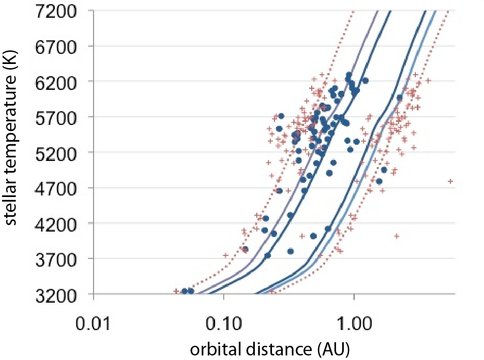2011 Annual Science Report
 Massachusetts Institute of Technology
Reporting | SEP 2010 – AUG 2011
Massachusetts Institute of Technology
Reporting | SEP 2010 – AUG 2011
Modelling Planetary Albedo & Biomarkers in Rocky Planets'/moons Spectra
Project Summary
Using data from Kepler and new ground-based detections, Lisa Kaltenegger and Dimitar Sasselov have identified which confirmed and candidate planets orbit within the Habitable Zone and could provide environments for basic and complex life to develop. They have also developed atmosphere models for extrasolar planetary environments for different geological cycles and varied environments for the advent of complex life. The team modeled detectable spectral features that identify such planetary environments for future NASA missions like the James Webb Space Telescope.
Project Progress
The CO-Is outlines a simple approach to evaluate habitability of terrestrial planets by assuming different types of planetary atmospheres and using corresponding model calculations (Kaltenegger&Sasselov 2011). This approach can be applied for current and future candidates provided by the Kepler mission and other searches. Candidates with radii below 2 Earth’s radii are consistent with models of potentially rocky planets. To first order the HZ depends on the effective stellar flux distribution in wavelength and time, the planet albedo, and greenhouse gas effects. The Co-Is provided a simple set of parameters which can be used for evaluating future planet candidates from transit searches.
The NASA Kepler mission (Borucki et al. 2011) recently announced 1235 planetary candidates, among them 54 in and close to the HZ of their host stars. The CO-Is used atmospheric models to explore the potential for habitability of Kepler planetary candidates.
Extent of the Habitable Zone for (left) water loss limit for 0% and 50% cloud coverage (inner limits) and 100% cloud coverage (outer limit dashed line), (right) runaway greenhouse onset and position of potentially habitable Kepler planetary candidates in the HZ, individual HZ limits are indicated with crosses (right).
Fig. 1 shows the extent of the HZ for the Kepler planetary candidates that could potentially be habitable. The three main points of the paper are: (1) to provide a simple approximation for habitability of Earth-like planets from the data provided by transit surveys like Kepler to assess their potential as a habitat, (2) to demonstrate that one needs to consider the individual stellar parameters to determine the limits of the HZ, and (3) to explore the change in the sample located in the HZ due to individual factors and associated errors.
Applying the analysis to the whole Kepler planetary sample of 1235 transiting planetary candidates, assuming the maximum Earth-like Bond albedo for rocky planet atmospheres (see Fig.1), results in 12, 27, 67 planetary candidates with Teq smaller than the water loss limit (Tsurf = 373K) for 0%, 50% and 100% clouds respectively, and 18, 43, 76 planetary candidates with temperatures lower than the runaway greenhouse limit respectively. Among those are 2, 3, 6 as well as 3, 4, 6 planets respectively, that have radii below 2 Earth radii consistent with rocky planets (KOI1026.01, 854.01, 701.03, 268.01, 326.01, 70.03).
CO-I Kaltenegger led two separate papers on the modeling for one of the two confirmed planets in the Habitable Zone with mass below 10 Earth masses, consistent with rocky planet models (see Fig.2).
Two confirmed potentially rocky planets, Gl 581d and HD 85512b in the Habitable Zone of their host stars (figure credit ESO).
Gl581d has a minimum mass of 7 MEarth , HD 85512b are the first two detected potentially habitable rocky Super-Earth. Our models confirm that a habitable atmosphere can exist on both Gl 581d and HD 85512b. We derive spectroscopic features for atmospheres with and without, assuming an Earth-like composition for Gl 581 d. We find that a minimum CO2 partial pressure of about 7 bar, in an atmosphere with a total surface pressure of 7.6 bar, are needed to maintain a mean surface temperature above freezing on Gl 581d. Future observations of atmospheric features can be used to examine if our concept of habitability and its dependence on the carbonate-silicate cycle is correct, and assess whether Gl 581d is indeed a habitable super-Earth.
Publications
-
Kaltenegger, L., & Sasselov, D. (2011). EXPLORING THE HABITABLE ZONE FOR KEPLER PLANETARY CANDIDATES. The Astrophysical Journal, 736(2), L25. doi:10.1088/2041-8205/736/2/l25
-
Kaltenegger, L., Segura, A., & Mohanty, S. (2011). MODEL SPECTRA OF THE FIRST POTENTIALLY HABITABLE SUPER-EARTH—Gl581d. The Astrophysical Journal, 733(1), 35. doi:10.1088/0004-637x/733/1/35
- Kaltenegger, L., Udry, S. & Pepe, F.A. Habitable Planet around. A&AL subm.
-
PROJECT INVESTIGATORS:
-
PROJECT MEMBERS:
Lisa Kaltenegger
Co-Investigator
Dimitar Sasselov
Co-Investigator
Phoebe Cohen
Unspecified Role
-
RELATED OBJECTIVES:
Objective 1.1
Formation and evolution of habitable planets.
Objective 1.2
Indirect and direct astronomical observations of extrasolar habitable planets.
Objective 4.1
Earth's early biosphere.
Objective 4.2
Production of complex life.
Objective 6.2
Adaptation and evolution of life beyond Earth
Objective 7.2
Biosignatures to be sought in nearby planetary systems

